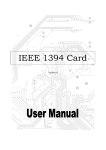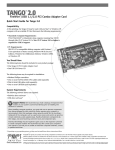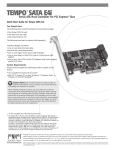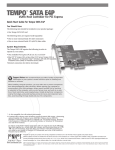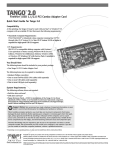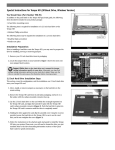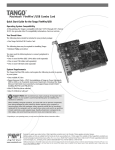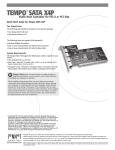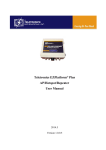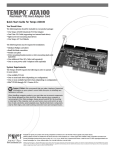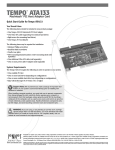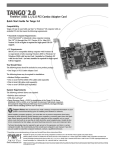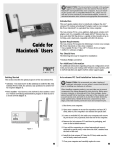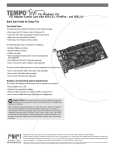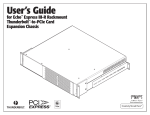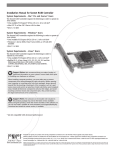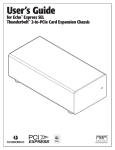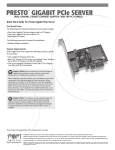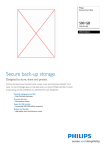Download ALLEGRO™ FW400
Transcript
ALLEGRO FW400 FireWire PCI Adapter Card ™ ® Quick Start Guide for Allegro FW400 Compatibility At this printing, the Allegro FW400 may be used with any Mac® or Windows OS computer with an available PCI slot that meets the following requirements: • Macintosh Computer Requirements: Power Macintosh® or Macintosh clone computer running Mac OS 9.0 through Mac OS X Version 10.5.x. Installation Steps Support Note: Technical knowledge may be required to gain access to the expansion card slots in certain computer models. We recommend you first consult your computer’s user manual. If you feel you are unable to install the computer hardware, contact a qualified technician. Allegro FW400 Installation Preparation Sonnet strongly recommends that you read the section in your computer’s user manual that addresses PCI card installation, prior to installing the Allegro FW400 into your system. Allegro FW400 Card Installation Steps 1. Shut down your computer. • PC Requirements: IBM PC/AT or compatible desktop computer with Pentium® II (or equivalent) or better running Windows 98 SE (Second Edition), Windows Me (Millennium Edition), Windows 2000, Windows XP, or Windows Vista. 2. Open your computer to access the expansion card area (PCI slots); refer to your computer’s user manual for specific information. You Should Have 4. Remove the Allegro FW400 card from its packaging. 3. Locate an available PCI slot inside your computer and remove its port access cover, if present, from the rear of the computer. The following item should be included in your product package: • One Allegro FW400 FireWire PCI Adapter Card 5. Install the Allegro FW400 into the PCI slot; make sure the card is firmly seated and secured. The following item may be required for installation: 6. Close your computer and carefully replace its cover. • Medium Phillips screwdriver FireWire Driver Installation Steps—Mac OS Computers You may need the following item to connect peripherals to the Allegro FW400: • One or more FireWire (IEEE 1394) cables (sold separately) System Requirements The Allegro FW400 requires the following in order to operate in your system: • One available PCI slot • FireWire driver software* Support Note: We recommend you make a backup of important information on your system’s current hard drive(s) prior to installing new hardware or software. When handling computer products, you must take care to prevent components from being damaged by static electricity. Before opening your computer or removing parts from their packages, always ground yourself first by touching a metal part of the computer, such as a port access cover, and work in an area free of static electricity; avoid carpeted areas. Handle all electronic components by their edges, and avoid touching connector traces and component pins. * Depending on your operating system, you may need to install drivers; instructions follow. 1 Support Note: Many peripherals require their own drivers and application software to operate or have full functionality. The Apple drivers already installed, or that you are about to install, in your system provide only limited support for some items. You should also install software included with the device, or available to download from the device manufacturer’s web site. Check the peripheral’s user manual for information about necessary software. The following section covers the installation of FireWire driver software in Mac OS computers; refer to the heading that describes your setup in this column or after. If you have a Windows PC, go to column 5 for Windows driver installation information. Mac OS 9.2.x and OS X If your system is already running Mac OS 9.2.x and/or Mac OS X, the Apple drivers that enable the FireWire ports on the Allegro FW400 have already been installed, and your installation is complete. When you upgrade to Mac OS 9.2.x or Mac OS X, the appropriate drivers will be installed automatically. Installation Steps (continued) Installation Steps (continued) 2. Double-click the Mac OS Install application icon. In the Select Destination window, click the Select button. Proceed through the next several screens until you reach the Install Software window. Click the Customize button. In the Custom Installation and Removal window, deselect all the Software component check boxes (click on each check or dash until the box is empty), except Mac OS 9.1. Click the pop-up menu to the right of Mac OS 9.1. Change from “Recommended Installation” to “Customized Installation.” The Select Mac OS 9.1 Features to Install window will appear shortly. 4. Read the information on the page, then click on the link to download the software. 3. Change “Recommended Installation” to “Customized Installation” from the pop-up menu. Deselect all the feature check boxes except “Network and Connectivity.” Click the arrow next to “Network and Connectivity” to view the features. Deselect all the features except “FireWire”. Click OK, Start, then Continue to complete the installation. After the software is installed, quit the Mac OS Install application and restart your computer from the hard drive where Mac OS 9.1 is installed; your installation is complete. Mac OS 9.1.x (Upgrade from Lower Mac OS Version) Complete these steps only when upgrading your system to Mac OS 9.1 from a lower Mac OS version; FireWire driver software will be installed automatically. Please note, if your system has built-in FireWire ports, you may skip these steps; your installation is complete. 1. Insert the Mac OS 9.1 CD into your computer’s CD-ROM drive. In the finder menu, select Special: Restart, then immediately press and hold down the C key on your keyboard until your system restarts and the Welcome to Mac OS screen appears. 2. Double-click the Mac OS Install application icon. In the Select Destination window, click the Options button and click the Perform Clean Installation check box that appears in the subsequent screen. Click the Select button. Proceed through the next several screens until you reach the Install Software window. Click OK, Start, then Continue, and complete the installation. After the software is installed, quit the Mac OS Install application and restart your computer from the hard drive where Mac OS 9.1 is installed; your installation is complete. Mac OS 9 (Upgrade from Lower Mac OS Version) Complete these steps only when upgrading your system to Mac OS 9.0 from a lower Mac OS version. 1. Insert the Mac OS 9 CD into your computer’s CD-ROM drive. In the finder menu, select Special: Restart, then immediately press and hold down the C key on your keyboard until your system restarts and the Welcome to Mac OS screen appears. 2. Double-click the Mac OS Install application icon. In the Select Destination window, click the Options button and click the Perform Clean Installation check box that appears in the subsequent screen. Click the Select button. Proceed through the next several screens until you reach the Install Software window. Click OK, Start, then Continue, and complete the installation. After the software is installed, quit the Mac OS Install application and restart your computer from the hard drive where Mac OS 9 is installed. 3. Log on to the Internet and type in: www.sonnettech.com/support/allegro400. 4. Locate and click on the link for FireWire drivers. 5. Read the information on the page, then click on the link to download the software. 6. Install the drivers, then restart your computer from the hard drive where Mac OS 9 is installed; your installation is complete. Mac OS 9.0.x (Existing Installation) If Mac OS 9.0.x is installed in your computer, you must download and install the appropriate FireWire driver software. Please note, if your system has built-in FireWire ports, you may skip these steps; your installation is complete. Mac OS 9.1.x (Existing Installation) Complete these steps only if you installed Mac OS 9.1 before installing the Allegro FW400. Please note, if your system has built-in FireWire ports, you may skip these steps; your installation is complete. 1. Turn on your computer. 1. Insert the Mac OS 9.1 CD into your computer’s CD-ROM drive. In the finder menu, select Special: Restart, then immediately press and hold down the C key on your keyboard until your system restarts and the Welcome to Mac OS screen appears. 3. Locate and click on the link for FireWire drivers. 2 5. Install the drivers, then restart your computer from the hard drive where Mac OS 9 is installed; your installation is complete. 2. Log on to the Internet and type in: www.sonnettech.com/support/allegro400. 3 4 Installation Steps (continued) Support Note: Many peripherals require their own drivers and application software to operate or have full functionality. The FireWire drivers already installed, or that you are about to install, in your system provide only limited support for some items. You should also install software included with the device, or available to download from the device manufacturer’s web site. Check the peripheral’s user manual for information about necessary software. FireWire Driver Installation Steps—Windows PCs Installation Steps (continued) Using FireWire Devices With the Allegro FW400 Windows 98SE This section describes the installation of drivers to support the Allegro FW400 in systems running Windows 98SE. 1. Turn on your computer; during Windows startup, New Hardware Found windows will briefly appear. Known Issues and Advice 2. When the Add New Hardware Wizard (PCI OHCI Compliant IEEE 1394 Host Controller) window appears, click Next. The following section covers the installation of FireWire (IEEE 1394) driver software in Windows OS computers; refer to the heading that describes your setup in this column or the next. If you have a Macintosh computer, go back to column 2 to find Mac OS driver installation information. 3. When the next window appears, insert the Windows 98SE CD into your computer’s CD-ROM drive, select “Search for best driver for your device (Recommended),” and then click Next. Windows Vista If your system is running Windows Vista, the drivers that enable the FireWire ports on the Allegro FW400 are installed in the background automatically during the first start-up after you finish installing the Allegro card. No further action from you is required; your installation is complete. 5. When the message stating “Windows is now ready to install the best driver…” appears, click Next. FireWire has many technological advantages over older interfaces such as ADB, Serial and SCSI, not least of which is its hot-plugging capability. However, there are limitations of which you should be aware; we have also listed some additional advice here. Refer to your peripheral manufacturers’ web sites and user guides for more specific information. •M any peripherals require additional drivers and application software to operate or have full functionality. Software should be included with the device, or available to download from the manufacturer’s web site. Check the peripheral’s user manual for information about necessary software. 4. When the next window appears, click Next. 6. When the message stating “Windows has finished installing the software that your new device requires,” appears, click Finish; the window will close; your installation is complete. Windows XP If your system is running Windows XP, the drivers that enable the FireWire ports on the Allegro FW400 are installed in the background automatically during the first start-up after you finish installing the Allegro card. No further action from you is required; your installation is complete. • Disconnecting FireWire peripherals (including external storage devices, cameras, memory card readers, etc.) while they are transferring or receiving data, may result in damage to the file(s) being transferred, or cause your system to hang. • Mac Users: Always unmount a drive from the desktop (eject or drag it to the trash) before disconnecting it from its cable or the Allegro FW400 card. • Windows Users: Always “stop”, “unplug”, or “eject” any drive connected to the FireWire ports before disconnecting it from its cable or the Allegro FW400 card. • Do not forget to connect external power supplies to the peripherals that require them. Although many peripherals may draw power directly from the Allegro FW400 card, other devices require an external power source. Windows 2000 If your system is running Windows 2000, the drivers that enable the FireWire ports on the Allegro FW400 are installed in the background automatically during the first start-up after you finish installing the Allegro card. No further action from you is required; your installation is complete. • When the Allegro FW400 is installed in a pre-G3 Macintosh computer, connected FireWire drives cannot be used as the system startup (boot) drive. Windows Me This section describes the installation of drivers to support the Allegro FW400 in systems running Windows Me. • When transferring data from a digital video camera to your computer through the Allegro FW400, we do not recommend using another FireWire device at the same time. 1. Turn on your computer; during Windows startup, a New Hardware Found window will appear. • Do not connect FireWire devices in a loop, nor terminate a FireWire chain; there are no terminators or ID settings required for any FireWire device. 2. When the Add New Hardware Wizard (PCI OHCI Compliant IEEE 1394 Host Controller) window appears, click Next. 3. When the next window appears, select “Automatic Search for a better driver (Recommended),” and then click Next. • Remember to register your product at http://registration.sonnettech.com to be informed of future upgrades and product releases. • Software updates and links are available from the Sonnet web site at www.sonnettech.com. 4. When the message stating “Windows has finished installing the software that your new device requires,” appears, click Finish; the window will close. Online support form: http://supportform.sonnettech.com. Customer Service hours: Mon.-Fri., 7 a.m.–4 p.m. Pacific Time Customer Service Phone: 1-949-472-2772 E-mail: [email protected] Tel: 1-949-587-3500 • Fax: 1-949-457-6350 Sonnet Technologies, Inc., Irvine, California USA 5. At the next prompt, click Yes to restart your system; your installation is complete. ©2008 Sonnet Technologies, All rights reserved. Sonnet, the Sonnet logotype, Simply Fast, the Simply Fast logotype, and Allegro are trademarks of Sonnet Technologies, Inc. Macintosh and Mac are trademarks of Apple Inc., registered in the United States and other countries. Other product names are trademarks of their respective owners. Product specifications subject to change without notice. QS-FW400-E-B-072508 5 6 7


